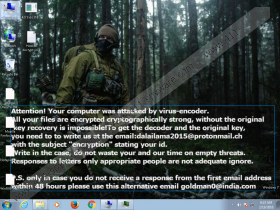Crysis Ransomware Removal Guide
Crysis Ransomware is not exactly a deceptive threat. Although it uses deception to enter your operating system, it will not try to hide its real goal which is to get your money. Once installed, this program will start encrypting the files found on your operating system. Once that is done, it will change your Desktop wallpaper to introduce you to the demands of its creators. The first line in this message states that you are under attack, and this should leave no questions about what is happening on your operating system. If you are still confused, we regret to inform you that your operating system was infected with a ransomware, and this is not just any ransomware. PadCrypt Ransomware and HydraCrypt Ransomware are the latest threats that we have added to the group, and they are different because they specifically target personal files. Now, if you do not delete Crysis Ransomware in time, you will find the installed programs, including browsers, paralyzed as well.
It is highly unlikely that many users will remove Crysis Ransomware before it initiates malicious processes. This infection is extremely quick, and once the AES encryption is initiated, it cannot be stopped. Of course, the key factor is the inconspicuousness of this ransomware. This threat does not require permission to enter your operating system, and it is unlikely that you will realize letting it in. For example, the installer of this malicious infection could be camouflaged as a photo or PDF file attached to a spam email. Just opening this file could unleash the ransomware, and its processes would be initiated without your knowledge. Of course, as soon as you find that your wallpaper was modified and that you cannot access any of the files or launch any programs, it should become obvious that Crysis Ransomware exists. Note that the files encrypted by this threat will gain an additional extension, as well as an email address that you are asked to contact. For example, you can rest assured that this ransomware has corrupted your files if you find chrome.exe renamed to chrome.exe.{dalailama2015@protonmail.ch}.CrySiS.
The demands of Crysis Ransomware are expressed via the wallpaper that automatically replaces your regular wallpaper, as well as TXT file called “How to decrypt your data.txt”. Whether you are looking at the wallpaper or the TXT file, you are ordered to do the same thing, which is to contact cyber criminals with the provided email and wait for further instructions. Here is an excerpt.
Attention! Your computer was attacked by virus-encoder.
All your files are encrypted cryptographically strong, without the original key recovery is impossible! To get the decoder and the original key, you need to write to us at the email: [email address] with subject “encryption” stating your id.
Most ransomware infections target personal files, such as music files, photos, and documents because they cannot be replaced easily. Crysis Ransomware targets all files, except for Internet Explorer and other Windows system files. Once this infection is done with the encryption process, you will not be able to open any programs or files, except for this browser. This window is left open so that computer users could send the email requested by the cyber criminals, as well as to pay the ransom. Unfortunately, we cannot guarantee that any of the files would be decrypted if you followed the demands, which is why you should consider other options. Look into authentic, legitimate decryption tools. Alternatively, delete all corrupted files and reinstall them anew. Needless to say, if you do this, your personal files will be lost for good, unless, of course, you have backed them up using an external drive or stored them online.
Whether you pay the ransom or not, in the end, you need to remove Crysis Ransomware. In order to be successful, you need to find the malicious executable file associated with this program. It can be very difficult to find this file because it can be found in one of many locations, and its name could change as well. Once you find this malicious executable, you also need to delete the RUN key using the Registry Editor tool. Additionally, do not forget to delete the wallpaper file (usually in the Documents folder). Finally, once this ransomware is gone, you need to implement reliable security software to prevent ransomware from attacking you again. Our recommendation for you is to use anti-malware software that provides both malware removal and Windows security services.
How to delete Crysis Ransomware
- Open Explorer (tap Win+E).
- Check every single one of these directories (enter into the address bar) to findthe malicious .exe file:
- %LOCALAPPDATA%
- %USERPROFILE%\Downloads
- %USERPROFILE%\Local Settings\Application Data
- %TEMP%
- %WINDIR%\System32
- Right-click and Delete the malicious file.
- Launch RUN (tap Win+R).
- Type in regedit.exe and click the OK button.
- Navigate to these paths and findthe value representing the malicious file:
- HKEY_LOCAL_MACHINE\SOFTWARE\Microsoft\Windows\CurrentVersion\Run
- HKEY_LOCAL_MACHINE\SOFTWARE\Wow6432Node\Microsoft\Windows\CurrentVersion\Run
- Right-click and Delete the value.
Crysis Ransomware Screenshots:


